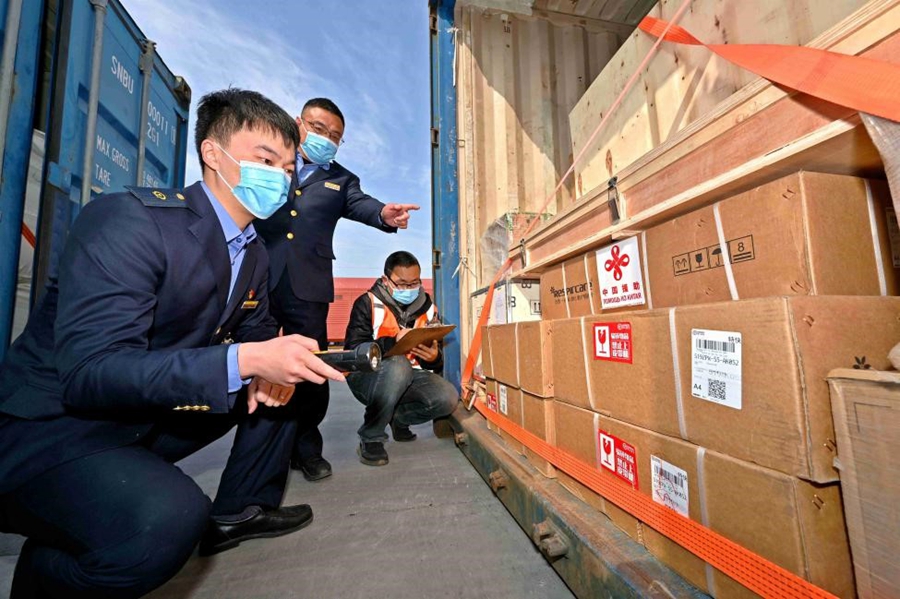




- BRNN
- BRI News
- BRNN News
- Database
Official Documents Polices and Regulations
Inter-government Documents International Cooperation BRI Countries
Business Guide Economic Data BRI Data
Trade
Investment Projects Latest projects
Cases - Content Pool
 |
| Photo taken on Feb. 23, 2021, shows railway staff of Xinxiang train depot in Zhengzhou, central China’s Henan province, examining and sealing boxes containing medical supplies provided by China for Kyrgyzstan. These medical supplies were carried to Alamedin of Kyrgyzstan by China-Europe freight trains. (People’s Daily Online/Wang Wei) |
On June 2, a China-Europe freight train, fully loaded with cargoes containing medical supplies and gym equipment, departed from a logistics park in north China’s Shanxi province for Paris. It was the first non-stop freight train from Shanxi to France.
According to data from China’s General Administration of Customs, China-Europe freight trains made a total of 1,941 trips and transported 174,000 Twenty-foot Equivalent Units (TEUs) of goods in the first quarter of this year, up 15 percent and 18 percent respectively from the same period last year.
As of May 2021, China-Europe freight trains had made 38,000 trips, carried 3.4 million TEUs of cargoes, and reached 151 cities in 22 European countries, suggested the data.
Ten years ago, the first China-Europe freight train, the Yuxin’ou (Chongqing-Xinjiang-Europe), departed from the Tuanjiecun Station in southwest China’s Chongqing municipality for the faraway city of Duisburg in Germany, thus ushering in a new chapter in the history of international railway transportation and offering fresh impetus to the trade between China and Europe.
Since the Belt and Road Initiative (BRI) was proposed by China in 2013, China-Europe freight trains have moved onto a fast track of development, with more and more Chinese cities, including Chengdu, Zhengzhou, Yiwu, Xi’an, and Urumqi, opening routes for China-Europe freight trains.
Over the past decade, China-Europe freight trains have continuously picked up speed, and facilitated connectivity and win-win cooperation among countries along the routes.
China-Europe freight trains have become one of the main means of land transportation in international logistics.
Compared with other freight transport means, China-Europe freight trains are safer, faster, more convenient and environment-friendly, and less likely to be affected by natural environment.
They carry a good number of types of goods, including clothing, daily necessities, electronic products, mechanical equipment, chemical products, wood and paper pulp, grain, fresh food in cold chain, as well as medical equipment.
Last year, Saic Fiat Powertrain Hongyan Co., Ltd. (SFH), a Chinese-Italian joint venture based in Chongqing, which mainly produces diesel engines and exports its products to Europe via China-Europe freight trains, saw the best business performance since it was founded in 2007, according to Federico Gaiazzi, general manager of the company, who added that the result was unexpected given that trade was seriously plagued by the COVID-19 pandemic.
China-Europe freight trains can help SFH save more than ten days of transport time compared with sea transportation, and have brought more profits to the company, said Gaiazzi.
As COVID-19 lock-downs have sharpened “foreign appetite” for China’s manufactured goods from electronics to home appliances, and a wave of demand in Europe stoked a sharp rise in transcontinental rail freight, many Chinese manufacturers have shifted from sea transport to safe, stable, and smooth China-Europe freight trains due to shipping delays and skyrocketing shipping prices, according to an article publish on the website of the Financial Times.
Since the outbreak of the COVID-19, the role of China-Europe freight trains in promoting mutual benefits and win-win cooperation has been further demonstrated to the world. They have not only transported much-needed anti-epidemic supplies, production goods, and daily necessities to European countries, but brought a great number of quality products from foreign countries to China.
China is not only the “world’s factory”, but the “world’s market” as it has 400 million middle-class consumers.
In Zhengzhou, capital of central China’s Henan province, many people are used to buying imported goods at a store selling products carried by China-Europe freight trains. Such products as pure milk from Germany, chocolates from Belgium, and French red wine are particularly popular among local consumers.
Imported luxury cars introduced by China-Europe freight trains can also be seen on the streets of some Chinese cities.
Although the COVID-19 is still raging around the world, China-Europe freight trains, which are dubbed “steel camel fleets”, are running in good order.
While conveying the ideas of mutual assistance and a community with a shared future for humanity, the freight trains have promoted the resumption of work and production as well as rapid reopening of economy in countries along the routes, greatly driving the stability of global industrial and supply chains and bringing new opportunities for global economic recovery and development.

Tel:86-10-65368972, 86-10-65369967